Friday Night Lights: A Non-American’s Guide to American Football
Friday Night Lights is available to stream on Netflix now. Here is a football guide for anyone who doesn’t know a touchdown from a touchback.
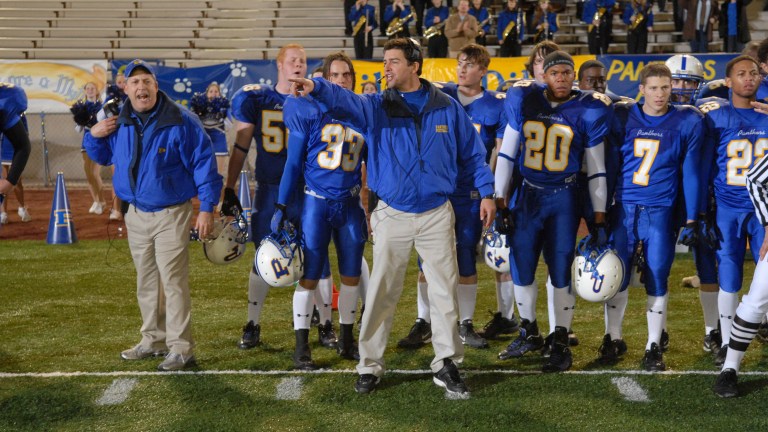
Friday Night Lights is now back on Netflix and you have to watch it.
Just to be clear, that isn’t a request – it’s an order. The NBC football drama is simply one of the most affecting, thrilling American TV shows of all time. Though premiering in 2006, the show can mark its lineage all the way back to a true story from the late ‘80s. In 1990, sports journalist H.G. “Buzz” Bissinger published the non-fiction book Friday Night Lights: A Town, a Team, and a Dream. The book follows the story of the 1988 Permian Panthers high school football team in Odessa, Texas as they make a run for a Texas state championship.
The book was adapted into a Peter Berg film of the same name in 2004, starring Billy Bob Thornton. The story of the Permian Panthers was dramatically rich enough to conquer two mediums already, but when a third was announced in the form of a TV series for NBC it seemed like overkill. Did the world really need more high school football drama after a successful book and movie? It turns out that the world really did.
Friday Night Lights, the TV show, further fictionalized Bissinger’s story. Odessa, Texas becomes the fictional Dillon, Texas (though the Permian Panthers logo remains a big yellow “P”). Kyle Chandler steps into the role of a new coach, the magnanimous Eric Taylor. Shot in a cinema verite-style where blocking is optional, Friday Night Lights makes the viewer feel like they are just another Dillon citizen, desperately dreaming for a state championship. Above all else, this empathetic show never speaks down to its small town characters.
As previously stated, Friday Night Lights is a must-watch. But if you’re one of our many non-American readers (Hello, everyone! I see you out there, writing “s” in words that need “z”), the football angle may seem like a real roadblock. So let’s tear down that roadblock. American football is the most popular sport in the United States but also perhaps its most impenetrable. The rulebook is thick and its connection to American culture deep. What follows is an attempt to explain American football for non-American viewers who are hesitant to tackle the show. Hopefully this will also prove useful to existing Friday Night Lights fans who have some questions about the game.
To simplify matters, we’ve broken our football school down into three parts: The Different Levels of American Football, which explains the sport’s place in American culture and why high school football is a big deal; The Rules of American Football, which is as succinct a distillation of how the game is played as possible; and The Strategy of American Football, which examines whether Eric Taylor is even a good coach anyway.
The Different Levels of American Football
Football is a pervasive force in American society. The highest level of play in the country (and the world) is the National Football League in which 32 teams of well-paid professionals compete against one another. The NFL is the richest sports league in the world by revenue and its championship, the Super Bowl, is usually watched by roughly 100 million people per year. Football’s influence doesn’t begin and end with the NFL though. The NFL doesn’t have a minor league or development system, so those interested in watching younger athletes are able to do so by following the sport on the collegiate or high school level.
College football is a huge deal. Some major universities’ football stadiums can house upwards of 100,000 fans. Four-year universities and colleges across the country field their own football teams that compete against one another in 12-game seasons (before a postseason consisting of “Bowl Games” but that’s too complicated to get into right now). Football at the collegiate level contains hundreds of teams split up into different leagues based on size and different conferences based on geography (for the most part). There isn’t any promotion and relegation like in European football leagues but if an institution grows big enough they can secure an invite to a higher level.
Though the decision-makers of the sport like to pretend it’s an amateur exercise and the players are not paid, college football is really a multi-billion dollar business. In fact, college football’s governing body, the NCAA, was just spooked enough by a U.S. Supreme Court decision that it allowed its athletes to finally pursue “Name, Image, Likeness (NIL)” deals in which they are allowed to make money from personal sponsorships.
Then we come to the high school level of football. Longtime viewers of American teenage dramas may have a pretty good idea of what a U.S. high school is now but here’s a primer for those who don’t. High school is the highest level of free public education in the U.S. before the more academically (and financially) strenuous college system. High school follows eighth grade (which together with seventh grade usually comprises of “middle school”) and consists of freshmen (ninth graders or 14-15-year-olds), sophomores (tenth graders or 15-16-year-olds), juniors (11th graders or 16-17-year-olds), and seniors (12 graders of 17-18-year-olds).
In some areas of the country, high school football is a bigger deal than college football or even the NFL. Though this level of the sport is played by essentially children, a high school football team may be the only competitive sports enterprise within hundreds of miles for some communities. This is particularly true in the massive U.S. state of Texas. Every region of the U.S. loves football, but passion for the sport is particularly acute in the Southeast, Midwest, and Texas. West Texas, where Friday Night Lights is set, is really high school football mad. The region is distinctly rural and far removed from the state’s three big cities – Houston, Austin, and Dallas. As such, high school football is the singular cultural force that many oil-drilling West Texas communities rally around.
High school football leagues across the country differ considerably, but like in college football, schools are generally grouped together by size and funding. Public and private high schools are able to compete in the same sports conferences as long as they have similar enrollments and budgets. Typically a high school football season consists of only 10 games (football is a physically brutal sport and as such plays far fewer games per year than other sports like baseball, basketball, or soccer). The regular season is usually followed by a bracket-style playoffs culminating in a state championship. There is no country-wide tournament, which is why “winning state” is the ultimate goal in Friday Night Lights.
The Rules of American Football
I won’t lie to you: this is going to be difficult. Explaining any sport from scratch is a tall task, let alone a sport as complicated as football. Let me attempt to do so from the ground up and please be patient. There will be some visual aids as well.
First, it’s probably helpful to know about the field that football is played on. There’s a reason why in some European markets that the sport is known as “Gridiron Football” and that’s because the field resembles a cooking utensil known as a gridiron.
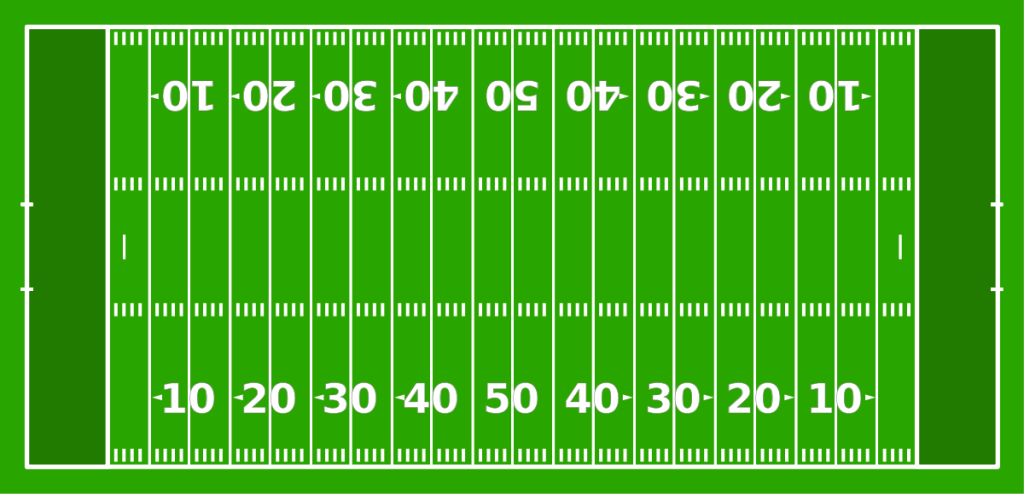
Every American football field consists of 100 yards (split into two sides of 1-50 yards). At the end of each side of the field is an “endzone.” A player entering into the endzone with the football is called a “touchdown” and nets a team six points. At the back of each endzone are the goalposts – yellow tuning fork-like structures that the ball is occasionally kicked through for more points. These are akin to rugby’s goalposts but slightly differently shaped. Let’s table the whole kicking thing for now and focus strictly on the action on the field.
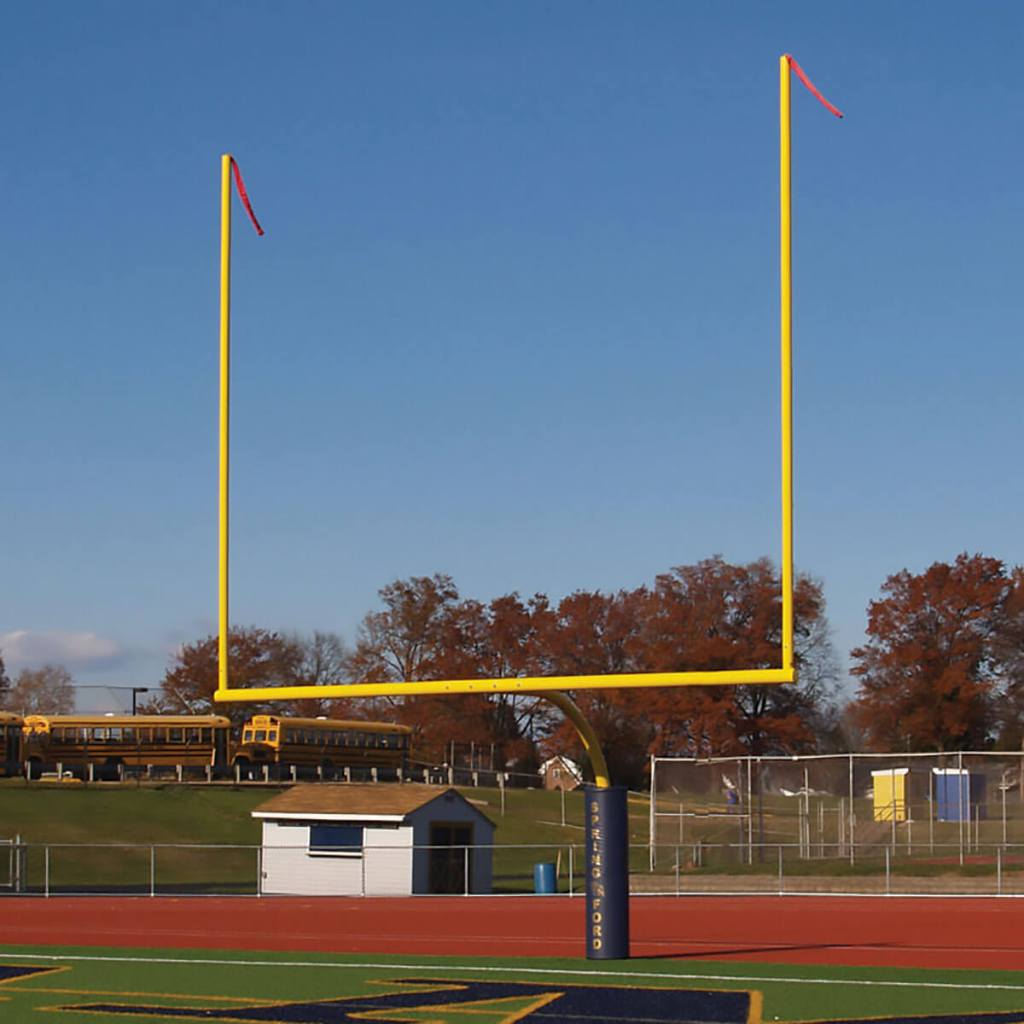
The goal of football is to enter into the endzone with the ball to score points and have more points at the end of the game than the other team. A football game is 60 minutes, split into four 15-minute quarters (with a lengthy halftime break after the second quarter). Eleven players take the field for each team, one side on “offense” and one side on “defense.” A coin is flipped at the beginning of each game to decide who gets to start as offense and who gets to start as defense. The team who began the game on defense will get to be the offense at the start of the second half.
The offense is charged with advancing the ball 100 yards down the field into the end zone, while the defense is tasked with stopping them by tackling the person with the football to the ground. The offense is granted four tries or “plays” to try to score. The action isn’t continuous in American football like it is in European football. After a team runs a play to attempt to advance the ball, they get a 40-second break to plot their next play. A play simply refers to the action on the field that the offense takes to get down the field. It begins with the “center” “snapping” the ball to the “quarterback” behind him and ends when the offense either scores (rare) or is foiled in some way – whether that means being tackled in bounds, stepping out of bounds, or throwing the ball out of bounds. Here is a chart of the typical football positions.
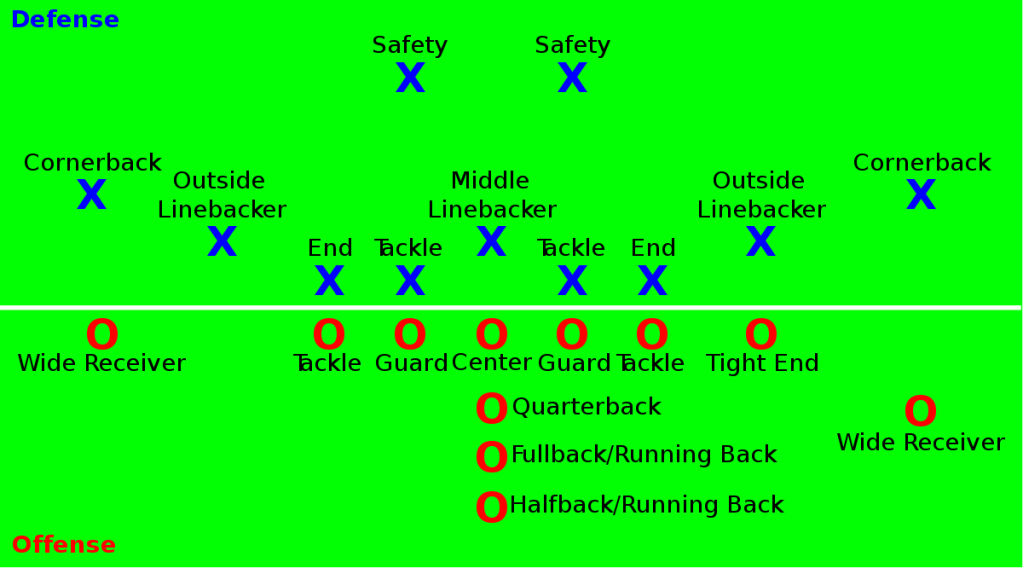
The offense’s two most reliable ways of advancing the ball downfield are either throwing it or running it. On a running play, the quarterback (Jason Street or Matt Saracen in Friday Night Lights) will receive the snap and hand it off to a running back (Smash Williams or Tim Riggins) who tries to run the ball upfield while his teammates block for him. Alternatively, the quarterback can throw the ball to an open wide receiver as long as the throw originates from behind the line of scrimmage (the area on the field where the play originated).
Four tries to reach the end zone are rarely enough opportunities for the offense. Thankfully, that’s where “first downs” come in. If the offense advances 10 yards, their “downs” or attempts to score reset back to the full four. That’s where terms like “1st and 10” or “2nd and 7” or “4th and 1” come from. The first number refers to which “down” or attempt the offense is on (1, 2, 3, or 4) while the second number refers to how many yards they need to reach to achieve another first down. Due to penalties or a player being tackled well behind the line of scrimmage (called a “sack” or a “tackle for loss”), the number of yards needed to reach a first down can exceed 10. One time in 2012, the Washington Football Team even had a “3rd and 50”, meaning they needed to move 50 yards for a first down.
If the offense fails to score or get a first down while on fourth down, possession of the ball is granted to the other team on the same spot that the offense failed. This is called a “turnover on downs.” The team that was previously on offense will bring their defensive unit into the game while the other team will bring their offensive unit. At the collegiate and professional level, players usually only play on one “side” of the ball – offense or defense. In high school, where the level of talent is more inconsistent, it’s not uncommon for several players to be on both the offensive and defensive units. This doesn’t come up much on Friday Night Lights though – for the most part the offensive players stay on offense and the defensive players stay on defense.
It is possible for the defense to force a turnover in other ways beyond just a turnover on downs. If the offense drops or “fumbles”’ the ball and the defense recovers it, it belongs to them. If the defense catches a ball thrown by the offense it is an “interception” and the offense suddenly becomes the defense and the defense suddenly becomes the offense. This situation factors prominently in Friday Night Light’s first episode.
Turnovers are awful, so the offense has a couple of tools to combat them. At any point during their drive down the field, the offense can choose to “punt” the ball. This means that if they’ve reached 4th down and are unlikely to convert a first down (if it is 4th and 10 from their own 30 yardline for instance), they can choose to have a kicking specialist called a “punter” enter the field. The punter receives the snap, tosses the ball up in the air, and punts the ball far down the field to the other team to catch and try to advance. This is a surrender from the offense but at least they’re making things a bit more difficult for the other offense by pushing the new offense further down the field. Punts rarely factor into Friday Night Lights as they aren’t particularly interesting.
Alternatively, if the offense is close to the end zone but not close enough that they’re confident they can reach it, they can attempt to kick the ball through the aforementioned goalposts for three points. A “kicker” is brought onto the field and attempts to kick the ball through the goalposts from the ground. A “holder” is allowed to hold the ball upright for the kicker but the ball must be touching the ground for the attempt to count.
Let’s delve a little further into the scoring system. We’ve mentioned that kicking the ball through the uprights is a field goal and nets three points while carrying the ball into the endzone is a touchdown and nets six points. But there are a couple other ways to score in football as well. After a touchdown is achieved, the offense is immediately granted the opportunity to score again. They must choose whether they want to kick the ball through the uprights from extremely close range (which nets one extra point) or to try to reach the end zone again from extremely close range (which nets two extra points). Additionally, if the offense is tackled in their own end zone, it nets two points for the opposing team and they receive the ball back via punt. This is called a “safety.”
To recap:
- Safety: 2 points
- Field Goal: 3 points
- Touchdown: 6 points (+1 for a field goal attempt, +2 for a scoring attempt).
This means that football scores can generate pretty much any result other than 1-0 or 1-1. Typically a “normal” scoring game will be somewhere between the 20-40 range in divisions of 7 or 3. A score of 35-28 is a pretty usual final football score.
Still confused? That’s understandable. Football is a fairly confusing sport at times. But hopefully you are a little better equipped to understand the action on the field in Friday Night Lights. The show certainly isn’t trying to present a complicated depiction of football. Armed with the basics, you should have a rough idea of what’s happening during all the football action.
If you feel like you’ve mastered the basics, feel free to move on to the final section of this piece.
The Strategy of American Football
The only constant in football is change. The rules of the sport are tweaked every single year and sometimes the sport undergoes truly massive alterations. In fact, the forward pass itself (now a staple of the game) wasn’t even legal for the first few decades of football’s existence. As such, the offensive and defensive strategies of football are in a constant state of flux.
What’s interesting to note about Friday Night Lights is how old-fashioned its depiction of football appears to be at the series’ beginning. Keep in mind that this story began with the 1988 Permian Panthers. So despite premiering and taking place in 2006, the Dillon Panthers offense looks quite antiquated at first.
The Dillon Panthers open the series as a run-first offense in a “Wing-T” formation. Running back Brian “Smash” Williams is the cornerstone of the Panthers’ strategy because back in the ‘80s and ‘90s, athletically superior running backs were usually the most dominant force in any high school offense. The Panthers plan of attack is to have a fast tailback (colloquially called a “running back” because they begin the play in the backfield and then…run) and a strong fullback in the backfield alongside the quarterback. The Panthers’ plan is to snap the ball, give it to the fast guy, have him follow the big blockers, then rinse and repeat.
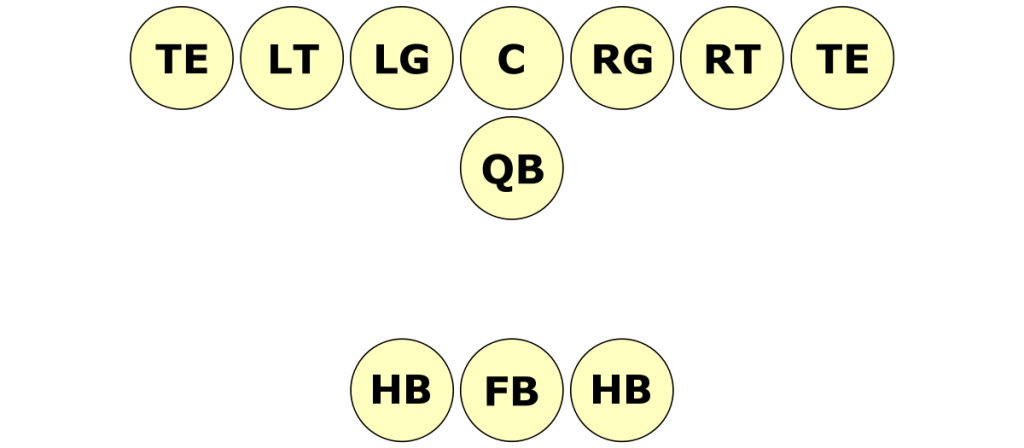
Interestingly enough, the show uses the primitiveness of the Panthers’ offense to its advantage in later seasons. When some parents and Panthers boosters (literally just rich people that support a high school or college team) want to oust Coach Eric Taylor, they point to his inability to change with the times and create a sophisticated passing attack as one reason. Coach Taylor does eventually attempt to implement a “spread” offense.
Spread offenses were all the rage at the high school and collegiate level in the early aughts. The “spread” strategy refers to “spreading” three to five wide receivers on the line of scrimmage to force the defense to cover them man-to-man. Defenses are always strategizing just like offenses, and by forcing the defense to spread out and guard many receivers, it takes away a lot of their more sophisticated coverage options (like double-teaming or divvying up the field into “zones” of coverage).
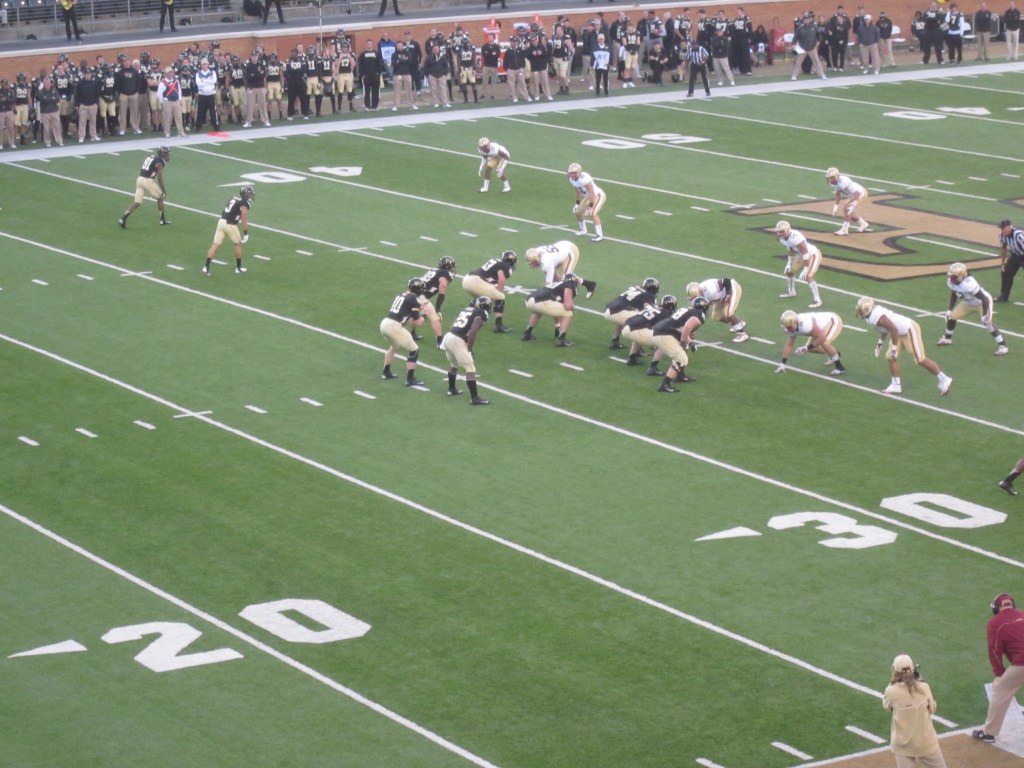
In later seasons, when Coach Taylor gains access to a fast, dynamic quarterback, he incorporates a bit of the “option” into his spread offense. This is where the QB uses the spacing from the spread to scan the field, analyze certain players’ positioning on the defense, and decide to pass the ball, hand off the ball, or run the ball himself.
Based on all this, it sounds like Eric Taylor is a pretty brilliant coach, right? Well, not exactly. The internet is littered with breakdowns of Taylor’s strategy from smart football minds. Most of said articles criticize him on two big fronts. The first is his tardiness in adapting to a pass-heavy offense. The second is his absolutely abominable clock management. Since the clock counts down in American football and there is no stoppage time, managing time is a huge part of a coach’s responsibility.
Since the show naturally wants to inject some drama into its football scenes, the Dillon Panthers as coached by Eric Taylor often have next to 0 clock awareness. This breakdown even notes than in the pilot episode, the Panthers somehow only move the ball 30 yards in five minutes of gametime. That is…pretty curious.
Also, while it’s not uncommon for a head coach to specialize in either the defensive or offensive side of the ball, Eric Taylor’s is particularly offensive-focused. Defensive plays aren’t as exciting to depict on television, so Coach Taylor is rarely shown coaching up the defensive half of his team. That’s a pretty big blindspot when it comes to head coaching.
Now that you’ve read through this full breakdown of American football, give Friday Night Lights a watch or a rewatch. Who knows – you may even be a sharper football mind than Coach Taylor at this point.

